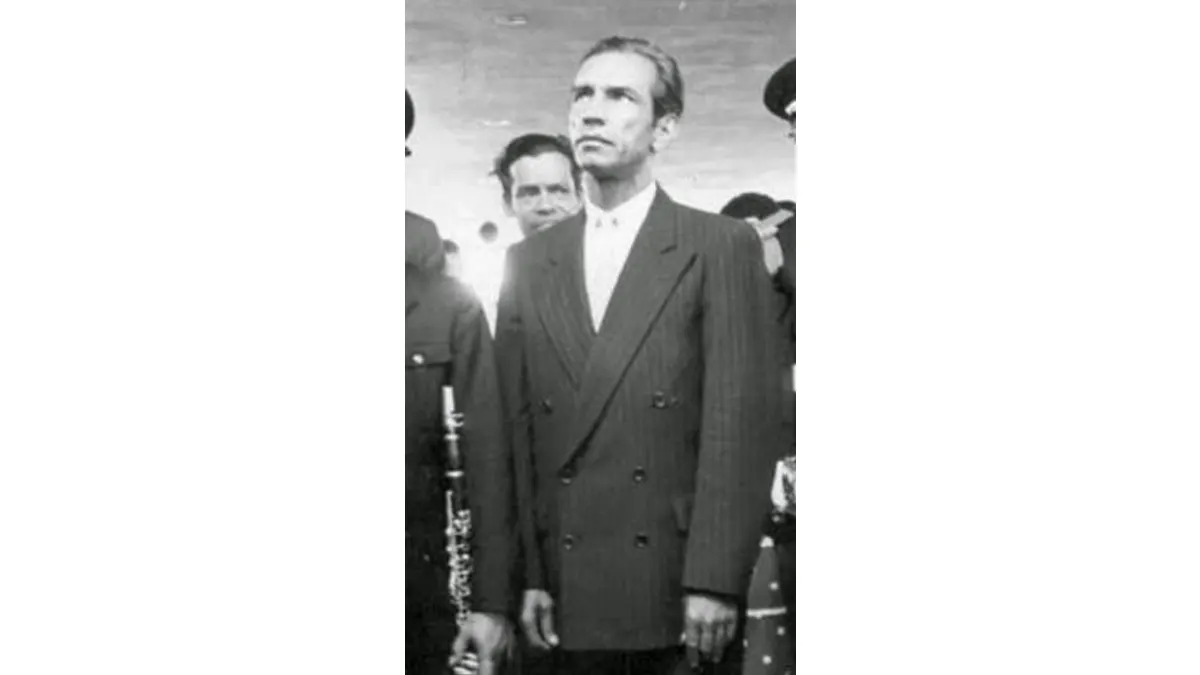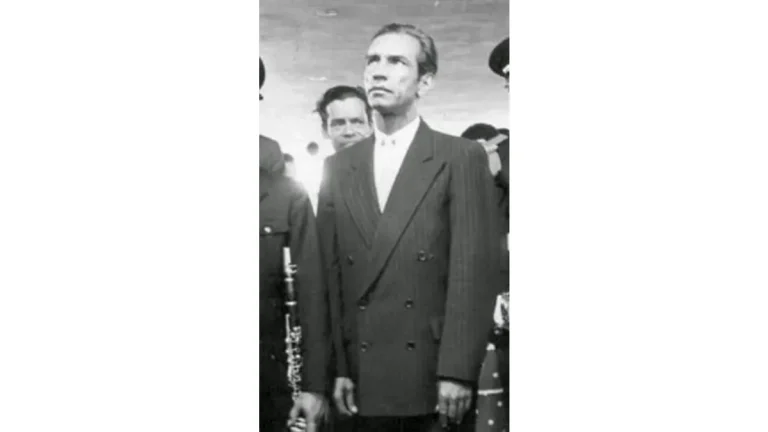Biography of Humberto Cano

Humberto Cano Romero was a violinist and composer. He was born in Tegucigalpa on February 12, 1902, and died in Tegucigalpa on August 14, 1986. His parents were Hipólito Cano and Doña María Romero de Cano.
Master Cano was one of the best violinists in Honduras and Central America, having studied music in Italy and other European countries, he received applause on this continent in the years between the two great world wars.
I also stand out as a magnificent composer, among his musical works the following stand out:

- Na Facunda
- The Stutterer
- the little ears
- cornfield
- the grinding
- Christmas Eve is coming
- Year 2000
- Whimsical Waltz
- around the honeycomb
Some of his songs have been recorded by artists and groups such as Trio Honduras, Voces Universitarias, La Estudiantentina de Derecho, Miguel Angel Mejía and others. For 10 years he served as director of the Band of the Supreme Powers of Tegucigalpa.
He received the Pablo Zelaya Sierra National Art Award.
Life of Humberto Cano
While still a teenager, his father sent him to Italy to study music because violin teachers in Central America no longer had to teach him.
Immediately after his arrival and after a rigorous examination, he was admitted to the Giuseppe Verdi Conservatory in Milan, where students are generally accepted for one year of probation before the confirmatory exam. Once the qualities of the new student were evidenced and to consider his case, the Examining Commission met on an extraordinary date, constituting the exceptional case of formally admitting him only 4 months after his admission as an applicant.
After three to five years, alumni of the Verdi conservatory are allowed to perform in public. Humberto Cano played at the Conservatory before completing the first year of studies.
In view of his family’s effort to keep him studying in Europe and the triumphs achieved in such a short time, the Honduran government granted him a scholarship of 90 dollars a month, which he only received for two months due to the outbreak of the Honduran revolt. 1924.
Here is an incident of great importance in the life of a music student; incident that came to endanger the future artistic career of the Honduran violinist.
The teachers Paolo, Anzoletti and Tua wanted to be Cano’s tutors, giving rise to a serious rivalry that reached acute characters, since in order to satisfy the first two mentioned teachers, the decision was drawn to chance. Paolo won, but Professor Anzoletti felt such a predilection for Cano that he threatened to withdraw from the Conservatory if he did not give in to his student.
The precarious situations he was going through forced Cano to play in the theaters of Milan at night, becoming at this time the best paid musician in the city.
When Professor Anzoletti found out about such a situation, he was opposed to Cano having to work to earn a living and since then he took him under his direct protection, offering him his home and his table so that he could fully dedicate his energies to the study of music.
Professor Anzoletti was so proud of his disciple that he and his sister asked him to add the Anzoletti surname to his name.
The Miss. Anzoletti, distinguished pianist and writer to whom Cano owes her solid humanistic training, died first and Professor Azoletti shortly after without having seen the career of her favorite student crowned with triumphs.
While his Master’s ill health lasted, Cano was given the honor of replacing him at the Conservatory in his teaching duties.
Before his death, Prof. Anzoletti made Humberto Cano universal heir to his assets, including a villa in Tranto. His violin, a Stradivarius valued at 300,000 dollars, was inherited to the conservatory with a clause authorizing Cano to play it at his concerts.
While still a student, Cano first played the violin under the direction of Arturo Toscanini in 1928, with the symphony orchestra of the Milan Conservatory.
For the final exam, Cano was presented at the Rossini conservatory in Pesaro by the famous Prof. Giovanni Chiti, before a tribunal of masters brought for the purpose from Parma, Florence, Naples, Milan and Rome.
After the execution was over, one of the examiners asked him what part of Italy he came from and when Cano replied that he was not Italian, the teacher regretfully expressed «CHE PECCATO»
Prof. Chiti, congratulating him, told him: stay dedicated to the violin because with it you can do whatever you want.
After graduation, Cano undertook a series of concert tours throughout Italy beginning with a formal debut in Milan. Among the concepts of criticism, are the following: Diario Popolo de Italia, in its edition of October 10, 1930 says: the violinist Humberto Cano last night through the program, has revealed himself as a virtuoso with an abundance of beauty in a sound, full of robust and impeccable performance.
“CORRIERE DE LA SERA” says: the violinist Humberto Cano, well known to our audience for his previous performances, revealed himself last night not only as a virtuoso and faithful performer but also as an exceptional mastery of the right hand.
With the laurels of consecration in the land of art par excellence and under the impulse of the emotion that triumph produces, his only desire was to return immediately to Honduras where he was received with open arms and all kinds of tributes were paid to him.
In this period, Cano composed his concerto in A Minor for violin and piano, the capricious waltz and around the honeycomb.
Due to the war in Ethiopia and when Honduras adhered to the economic sanctions against Italy, Cano was invited not to work for a stipend in Italy, granting him the privilege of remaining in the country if he so wished. Humberto Cano preferred to go to Switzerland in order to actively follow his work. In this country he was made a tempting offer to teach at a Conservatory as long as he renounced his nationality and adopted the Swiss one; he preferred to continue to France where in Paris, where the patronage of Dr. Julian López Pineda, then Honduran Minister in Paris, presented a concert at the Salle Corteau.
After the concert, one of the critics from the daily press in Paris showed Cano and the compatriots who were with him, Dr. López Pineda, Lic. Marcos Carias Reyes and Dr. Rosendo Martínez, the critical notes they had written to the concert unfold. Among them, Cano was compared to Jan Rubelik, considered in his time as the violinist with the best critics in the world. Cano’s modesty steadfastly opposed the publication of the trial, and so it happened.
From France he went to Germany and after a concert in Hamburg, the newspaper “Hamburger Tageblatt” stated in its edition of October 13, 1936, the following: “as a performer and composer at the same time Humberto Cano walks arm in arm with Pablo de Sarasate and Master Granados”
The opinion of the rest of the Hamburg press on that occasion was more or less unanimous and the Honduran Consul in Hamburg, Dr. Magín Herrera A. sent to Honduras the clippings of opinions that were translated and published in the Central American press. After a joint performance with other artists from Berlin, the local press declared almost solely that the highlight of the concert had been the performance of the Honduran violinist Humberto Cano.
Back in Italy again, Cano dedicated himself to perfecting his technique and preparing for his great continental tour of the Americas. But before leaving he went to Hartenstein, Germany in search of the most famous violin teacher Prof. Siegfried Eberhardt, to whom he introduced himself as just another student. After a brief discussion on technical issues, Master Eberhardt explained to Cano that after 40 years of research and effort, he had managed to develop the necessary technique to solve a difficult bow handling problem ensuring that only half of the bow could be traversed. up or down to give certain effects because there was an anatomical impediment in the human arm, which limited, in his opinion, the number of notes that could be played in one arcade.
Prof. Eberhardt asked Cano to execute his instructions, with 4 notes, then with 8 and so on up to 32, to the great surprise that Cano did not do it with the full length of the bow. Surprised, the Master invited him to teach together, but Cano had his trip planned to the new world and only accepted for a short time.
Prof. Eberhardt’s enthusiasm reached such a point that he proposed to Cano to go with him to establish a conservatory in Honduras, which would undoubtedly be the attraction of all violinists in the world. Unfortunately the war broke out and although Cano had paid for his ticket, he was unable to leave Germany, where in order to live he had to see his financial security consumed.
In December 194, the situation became more narrow as Honduras entered the war against Germany. At first, Cano was only forced to report daily to the police, but then his passport was invalidated and he had to place himself under the protection of the Swiss consulate, which was in charge of obtaining a new one from Honduras, which took 8 months.
When the allied bombings punished the German cities, to raise the morale of the people, the Nazis distributed double rations of coffee, sugar, etc. Cano never separated from his violin, which earned him freedom more than once.
Cano hoped to be exchanged but this never happened, until after the war he was able to go to Paris, where thanks to his brilliant execution, he obtained considerations such as being housed in a private room in the Paris reunion camp, while the other returnees were crammed up to fourteen into a room and that for a few days while they were sent to a camp on the outskirts of Paris, more than a hundred kilometers away. The captain-chief of the meeting center in France proposed to Cano that he stay in Paris and that he would help him establish himself.
Cano preferred to return to his homeland where he spent a year and a half recovering. Shortly thereafter he moved to the United States with the position of Cultural Attaché at the Honduran Embassy in Washington where he hoped to have the opportunity to restart his artistic career interrupted by the war.
Humberto Cano, was the first Director of the National Academy of Music, founded in the government of Juan Manuel Gálvez. He was also Director of the Band of the Supreme Powers. Cano, for many, is considered the best violinist in Honduras, he died on August 14, 1986, in Tegucigalpa.
Source: Chronicles of Honduras


